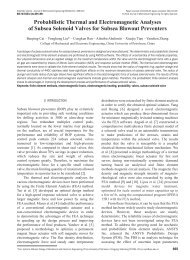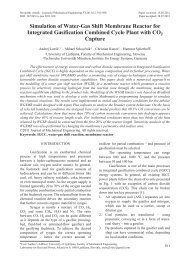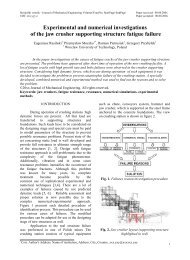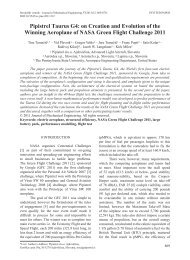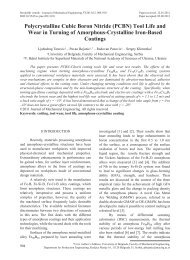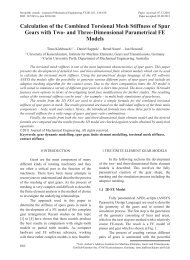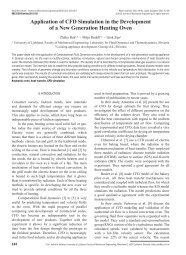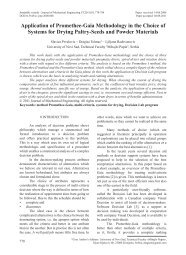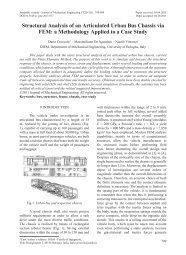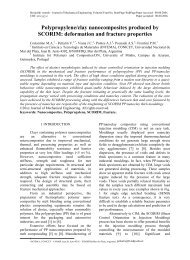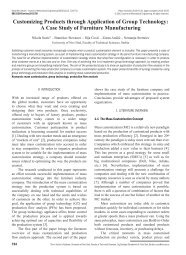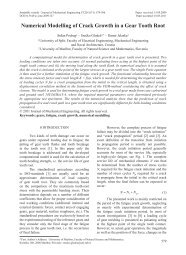Computation of Stress Intensity Factor in Functionally Graded Plates ...
Computation of Stress Intensity Factor in Functionally Graded Plates ...
Computation of Stress Intensity Factor in Functionally Graded Plates ...
Create successful ePaper yourself
Turn your PDF publications into a flip-book with our unique Google optimized e-Paper software.
Strojniški vestnik - Journal <strong>of</strong> Mechanical Eng<strong>in</strong>eer<strong>in</strong>g 57(2011)7-8, 622-632Fig. 2. Transient temperature distribution <strong>in</strong> theFGP (ZrO 2 /Ti-6Al-4V) for various normalizedtimes with T 1 / T 0 = 0.2 and T 2 / T 0 = 0.5The exponent p is a positive constantused as an adjust<strong>in</strong>g parameter to obta<strong>in</strong> certa<strong>in</strong>distribution for material properties. As theexponent p can be chosen <strong>in</strong>dependently from thecomprised materials, this function is significantlyflexible and hence widely used <strong>in</strong> practice forthe analysis <strong>of</strong> the FGMs. In the proportionalmaterial properties, the exponent p is assumedthe same value for all material properties while itcan be selected differently for non-proportionalmaterials.Fig. 3. Normalized K I <strong>in</strong> the ZrO 2 /Ti-6Al-4Vplate versus normalized time and different cracklengths <strong>in</strong> plane stra<strong>in</strong> conditionAs the f<strong>in</strong>al po<strong>in</strong>t, the magnitude <strong>of</strong> SIF forthe plane stra<strong>in</strong> is larger than plane stress. Noda etal. [14] have derived thermal stresses analyticallyfor a homogeneous isotropic strip under onedimensionaltransient temperature distribution.These results <strong>in</strong>dicate that the thermal stresses forthe plane stra<strong>in</strong> case are equal to those <strong>of</strong> the planestress multiplied by a factor <strong>of</strong> 1/(1-ν). Regard<strong>in</strong>gthe fact 0 < ν < 0.5, this factor is greater than one,which implies a larger SIF for the plane stra<strong>in</strong> <strong>in</strong>comparison to the plane stress problem, which canbe noticed from Figs. 2 and 3.5.2. FGP with an Edge Crack with Power LawGradationA Ni/TiC plate with the configuration <strong>of</strong>the first example is considered here and a powerlawfunction is assumed to describe the materialproperties <strong>in</strong> the x 1 -direction e.g., as follows.Ex ( ) = E( 0) + ( E( W) − E( 0))( x / W) p . (20)1 1Fig. 4. Normalized K I <strong>in</strong> the ZrO 2 /Ti-6Al-4V plateversus normalized time for different crack lengths<strong>in</strong> plane stress conditionMoreover, here different thermal boundaryconditions are imposed on the uncracked face <strong>of</strong>FGP. To apply a thermal shock, the cracked face isassumed to be quenched to a constant temperature<strong>of</strong> T 1 = 0 while hav<strong>in</strong>g the free convection atthe other face with a convection coefficient <strong>of</strong>h=10 W/(m 2 K) and the ambient temperature isassumed T 0 . The transient temperature distribution<strong>in</strong> the Ni/TiC plate is presented <strong>in</strong> Fig. 5 for theproportional case with p = 5. The effect <strong>of</strong> theconvection boundary condition at the x 1 = Wface on the temperature distribution is moreapparent at the steady-state. Figs. 6 and 7 showthe transient thermal SIF versus crack lengthsfor the proportional case with p = 5 and p = 0.2,respectively. As can be seen, the variation <strong>of</strong> thethermal SIF is completely different for these cases.In the ceramic-riched case (p = 5), at the beg<strong>in</strong>n<strong>in</strong>g<strong>of</strong> the thermal shock the SIF <strong>in</strong>creases to a peakvalue and decl<strong>in</strong>es to its m<strong>in</strong>imum quickly andthen <strong>in</strong>crease gradually to a steady-state value.However, <strong>in</strong> the metal-riched case (p = 0.2)the SIF <strong>in</strong>creases quickly to a peak value and thendecreases rapidly until the crack is closed. The<strong>Computation</strong> <strong>of</strong> <strong>Stress</strong> <strong>Intensity</strong> <strong>Factor</strong> <strong>in</strong> <strong>Functionally</strong> <strong>Graded</strong> <strong>Plates</strong> under Thermal Shock627



